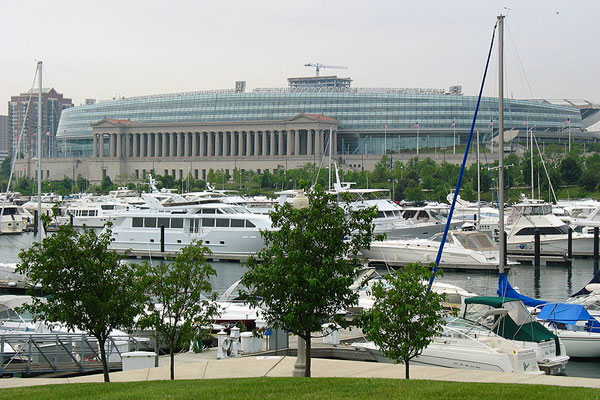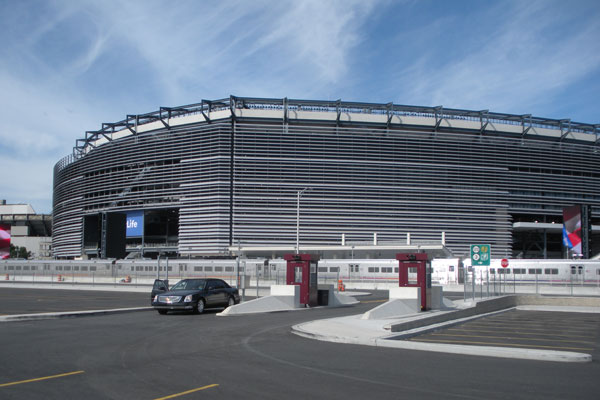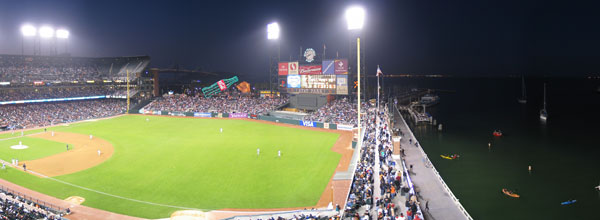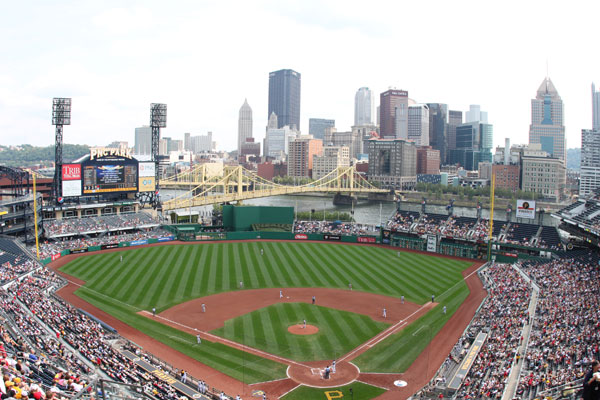In Grantland, veteran sportswriter Peter Richmond has a rant about New York City's trifecta of dull new sports stadiums, completed by New Meadowlands Stadium, which he unaffectionately calls The Lump. He compares the last of those unfavorably to… Soldier Field?
Nearly two dozen firms turned it down ("You want to build a new stadium without knocking down the 90-year-old skin? Dream on"). Greeted by resounding derision when it was unveiled in 2003, it's now considered a complete success, an integral art of the second-city's first-city architectural status.
I'm not entirely sure it's considered a complete success; I still think it looks desultory from the west, though the view from Northerly Island is pretty spectacular:

That aside, it's certainly a sight better than New Meadowlands, which looks like a giant air conditioner:

Or as the New York Daily News's Ralph Vacciano put it, after describing the stadium's color scheme, which is basically that of a federal prison:
It’s not only the color scheme that jumps out, either. It’s the design. It’s big, gray, very boxy and lacking in charm. I’ve seen every NFL stadium in the country and a majority of the baseball stadiums, too. And while I concede that most football stadiums lack the personality and charm that baseball stadiums tend to have, many of them have something. This one does not.
So what happened? This, I thought, was the most interesting part of Richmond's piece, a quote from Peter Eisenman, who designed University of Phoenix Stadium (home of the Arizona Cardinals), as well as Berlin's Holocaust Memorial (emphasis mine):
"Going into the new stadium is like going into a Hyatt Regency hotel," he says. "It's sad; we missed an opportunity. There was no energy. There was nobody in the press who cared."
Reading that made me grateful to live in Chicago, where architecture is regularly front-page news, even when it's regarding architecture that isn't actually being built here. It made me grateful for the lengthy, heated debate over whether New Soldier Field was an innovation or a sacrilege. It made me grateful for the city's conservative attitude towards Wrigley Field, where the act of installing ads is treated as a civic imposition, even though I don't always agree with it. It's an argument for the idea that extremism in defense of architecture is no vice.
Having said that, I don't think that stadium architecture is in decline. Recent baseball stadiums, or at least ones not in New York, while not inventive in the manner of the international stadiums Richmond cites, integrate the city into the experience, like AT&T Park in San Francisco and PNC Park in Pittsburgh:


In 2008, Chicago's Jeff Ruby toured seven Midwestern baseball stadiums—all relatively new, except for Wrigley—and found that the worst of them was U.S. Cellular:
The wife's a Cubs fan, and quick to begin the Cell-bashing, recounting all the usual grievances: The ballpark was the result of the owner's threat to relocate to Tampa; it had the misfortune of preceding the retro-classic revolution that began with Baltimore's Camden Yards; that steep upper deck gives people vertigo; the surrounding neighborhoods have zero attractions. Besides, she continues, the stadium is cold and impersonal.
[snip]
My wife has old information. The Cell, the first major-league park built by HOK Sport (the company seemed to have gotten all of the mistakes out of its system with this design), has addressed several of the problems. The Sox removed nearly 7,000 seats from the upper deck and shifted the bullpens to make room for more bleachers.
It's actually true, and pretty remarkable: The Cell is a lot less bad than it used to be. Removing the upper deck made the stadium simultaneously less imposing and claustrophobic.
Richmond's biggest complaint is that American stadiums are conservative, and that he's actually right about. Even AT&T Park, which would be my preference to watch a game in out of any baseball stadium I've ever been in, is conservative in the retro-Camden Yards vein. But I think it's just as much in response to the years of crappy, boring stadiums that gave us the old Busch Stadium, Veterans, Three Rivers, and Riverfront—generic multipurpose toilet bowls that looked like something out of Soviet Russia. Seriously.
The dark ages of American sports stadiums has actually passed, and here in Chicago, it surrounds us: the point just before the wave broke (U.S. Cellular and the atrocious United Center), the storied past everyone's lining up to imitate (Wrigley) and an odd, fascinatingly controversial attempt at the future (Soldier Field). But given how bad it was, and how many years it took to recover, it's unsurprising that we're still taking baby steps out of it.
Photographs: Zukie44 (Soldier Field); Donnie (Meadowlands); Daniel Schwen (AT&T); daveynin (PNC)


